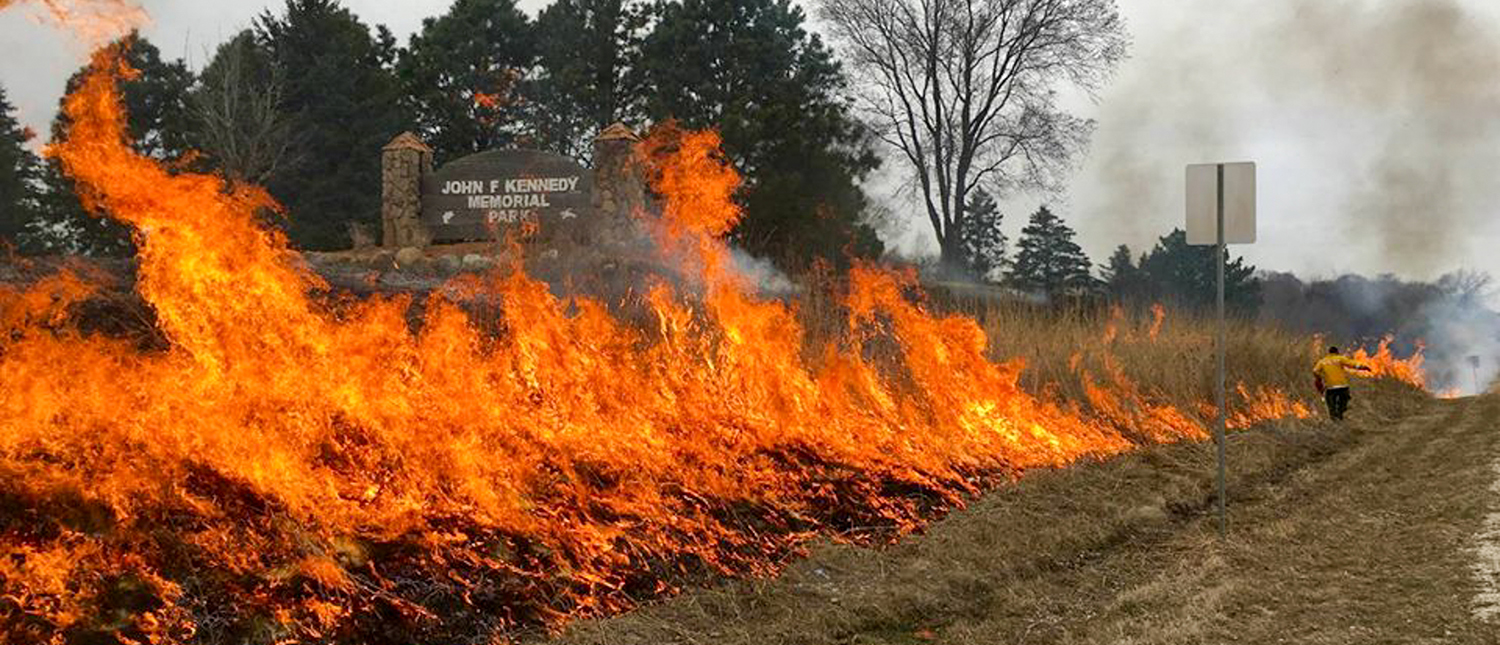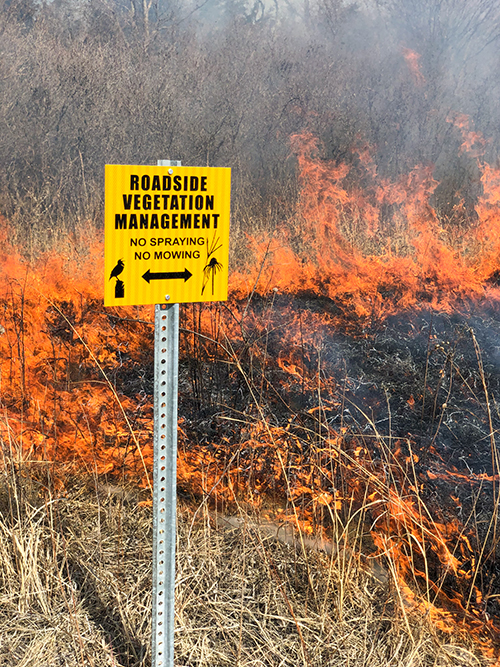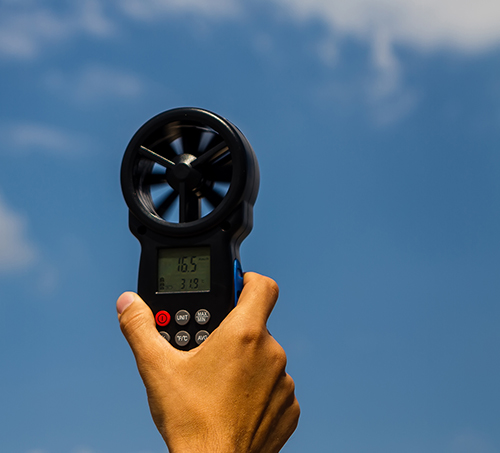Chapter 9: Prescribed Burning
Chapter 9: Prescribed Burning thompsbb
Prescribed fire is an essential component of native vegetation establishment and management. Though there are challenges associated with the process, prescribed burning can be executed safely and effectively in the roadside environment.
Prescribed fire is a management tool used for three main objectives:
- Discourage the growth of invasive and woody plants.
- Invigorate the growth of native plants.
- Remove thatch (including crops that end up in the right-of-way from flooding or wind) and biomass to help open ditches to help with water infiltration.
A timely burn can slow the growth and spread of weeds and small trees, both of which are susceptible to the intense heat of the fire. On the other hand, most native prairie species respond positively to fire. Historically, this ecological relationship was critical to the existence of the tallgrass prairie, and today, it continues to be an essential management practice for roadside prairie remnants and plantings.
The keys to a successful and safe prescribed burn are adequately trained staff, the right equipment, and advanced planning.
Training Requirements
Training Requirements thompsbb
Training Requirements
Though there are no statewide minimum training requirements for individuals participating in roadside burns, the Iowa Department of Natural Resources (DNR) offers training that provides basic information about executing safe prescribed burns.
The minimum recommended training to participate in a prescribed roadside burn is the Introduction to Wildland Fire series that covers the basics of fire behavior and wildfire firefighting techniques, consisting of the following courses:
- NWCG S-130, Firefighter Training (Wildland) Q0900 - S130
- NWCG L-180, Human Factors in the Wildland Fire Service Q0902 - L180
- NWCG S-190, Introduction to Wildland Fire Behavior Q0901 - S190
These courses, totaling 40 hours, are offered online through the Wildland Fire Learning Portal, maintained by the National Wildfire Coordinating Group’s Wildland Fire Learning Portal Governance Board. An in-person field day is required to receive certification for this training. The Iowa DNR Fire Management Training website includes a calendar with upcoming in-person training days. The website also has an Iowa Annual Fireline Safety Refresher that can be completed online.
Roadside managers and other staff wanting to go beyond the introductory training to add more expertise to the crew conducting prescribed roadside burns can become certified as a Firefighter Type 2 (FFT2). This is also known as “red card” certification, in reference to the card that FFT2s receive, certifying they are qualified to work on wildland fires. For more information on becoming certified, check the Wildland Fire Learning Portal.
Staffing Requirements
Staffing Requirements thompsbbStaffing requirements for roadside burns vary with the conditions at each site; the recommended size of the crew depends on the size and complexity of the burn. As a general rule, two to four qualified people can safely execute most roadside burns. Burning alone or conducting an understaffed burn is not advised. Coordination with other agencies may be necessary if internal staffing is inadequate. Possible collaborators include secondary road maintenance crews, county conservation boards, local fire departments, and other county IRVM programs.
Personal Protective Equipment
Personal Protective Equipment thompsbbPersonal Protective Equipment (PPE) standards vary among agencies.
Minimum Suggested PPE
If specific policies are not in place, the following minimum PPE is recommended:
- leather work boots
- gloves
- safety glasses
- clothing made of natural fibers
Highly Recommended PPE
The following PPE is recommended to further enhance safety:
- helmets
- face and neck shrouds
- fire retardant clothing such as Nomex (brand name heat- and flame-resistant suits and jackets)
- goggles
Ignition, Fire Fighting, and Other Safety Equipment
Ignition, Fire Fighting, and Other Safety Equipment thompsbb
All ignition and fire-fighting equipment should be inventoried, inspected, and tested prior to the burn season and immediately before each burn.
Refer to the LRTF Funding Guidelines for details on which equipment is eligible for purchase via grant funding and the ordering procedures. Much of the equipment needed for prescribed burning can be purchased from vendors such as those listed below.
Ignition Tools
Drip torches are the most efficient tool for igniting prescribed burns.
Inventory
- two drip torches containing a 2:1:1 diesel/kerosene/gasoline mix or, if kerosene can’t be found, a 2:1 diesel/gasoline mix
- pre-mixed fuel in safety cans
- lighters
Hand Tools
Hand tools are used to remove combustible materials and smother fire. They are often used to create fire lines and mop up after the burn.
Inventory
- rubber flappers (similar to a rake but with flat or bristled rubber on the head used to swat out flames or embers)
- shovels
- fire rakes
- gas-powered blowers
- fire brooms
Water Supply

Numerous styles of water tanks and pumping systems are effective for roadside burns. Some systems are designed specifically for fire suppression while others can also be used for additional management practices such as herbicide application. Additional features such as fire resistant hosing, electric hose reels, and adjustable pattern spray guns improve the effectiveness of the rig.
Tractors and ATVs can also be equipped with tanks and water pumping systems. These rigs can quickly access locations that may be inaccessible to larger equipment. They have smaller tank capacities, but can move personnel and equipment more efficiently along the fire line.
Inventory
- ¾- to 1-ton truck equipped with a 300–400 gallon tank and pump
- tractor and/or ATV equipped with 50–100 gallon tank and pump
- backpack pump sprayers
- additional storage tank or trash pump to refill equipment
Communication Devices
Effective communication with the burn crew during a prescribed fire is crucial. It is also important to maintain a communication link with agency headquarters and local authorities before, during, and after a burn.
Inventory
- two-way radios
- cell phones
Weather Data Collection Devices
Weather data must be collected to ensure conditions are within the parameters of the burn plan. Handheld weather units are inexpensive, accurate, and the most effective means of monitoring on-site weather conditions. Hourly weather observations are also available from the National Weather Service for specific areas.
Signage and Traffic Control Devices

The use of warning signs and other traffic control devices is highly recommended. The extent of the warning measures needed depends on the impact on traffic flow and the difficulty of the burn.
Inventory
- warning signs reading “Prescribed Burn Ahead” or similar
- vehicles with flashing lights
- flaggers
Public Notification
Public Notification thompsbbPrior to a burn season, the public needs to be notified that trained personnel will be conducting prescribed burns in the roadsides to achieve specific vegetation management objectives. A simple press release emailed to the local media (see Appendix 9A for a sample) will suffice, and may result in additional media coverage of the IRVM program. Adjacent landowners can be notified in person or by letter (see Appendix 9B for a sample). Roadside managers should address any questions or concerns that result from the press release or letters.
Developing a Plan For the Season
Developing a Plan For the Season thompsbb
Goals and objectives for the burn season should be established in advance. This includes developing a list of potential burn sites and prioritizing that list. A simple spreadsheet is a good way to compile and organize this data. The sample spreadsheet in Appendix 9C is an example of a chronological history of when sites were burned. With a spreadsheet organized in this manner, the roadside manager can prioritize the sites to be burned during the upcoming season based on considerations such as how long ago the site was last burned, with more recently burned sites receiving lower priority, and the composition of the vegetation. Sites in areas that are highly visible to the public, such as near nature centers or paved roads, may benefit from a burn to invigorate the native plant community. Sites with invasive herbaceous or woody vegetation that could be reduced with a prescribed burn may also receive higher priority than other sites.
There is often only a small window of time during which conditions are appropriate for prescribed burning. For this reason, it is critical to establish clear objectives so sites can be prioritized for burning. A reasonable goal is to burn native prairie remnants or plantings once every 3–5 years. Some sites may require more frequent burns and higher prioritization to address weed or brush infestations. As a general rule, any burn is better than no burn. Therefore, it is common to burn whenever conditions are favorable. However, there are optimal times to conduct most prescribed burns, depending on the intention of the burn. Refer to Table 9.1 for a breakdown of optimal timing for burns with different intended goals.
| Intention for a Prescribed Burn | Optimal Timing to Conduct a Burn |
|---|---|
| Routine maintenance (i.e., thatch removal) | Any time |
| Weed control* | Late spring |
| Brush control* | Spring |
| Stimulate growth of warm-season grasses | Mid-to-late spring |
| Stimulate growth of cool-season grasses | Enhanced by early spring and fall burns, suppressed by late spring burns |
| Stimulate growth of forbs | Enhanced by early spring and fall burns |
*Research specific weed and brush species before using fire for management. Some undesired species may have a positive response to fire, rendering prescribed burning an ineffective management approach.
Developing Burn Plans For Individual Burns
Developing Burn Plans For Individual Burns thompsbbA complete burn plan is the first step toward executing a successful burn. Refer to Appendix 9D for a sample prescribed burn management plan, which includes the following details.
Location
Identify the areas within a burn site that will benefit most from prescribed fire. A complete burn of an area is not always desired. Leaving some areas unburned allows many insects, birds and small mammals to find refuge from the fire. A mosaic of burned and unburned areas is ideal, as it allows wildlife populations to persist.
Weather Parameters
Weather is the most significant external factor influencing fire behavior, so it is crucial to determine the weather parameters within which each burn can be safely conducted. The following are reasonable guidelines for conducting most roadside burns.
- Temperature: 40–70°F
- Relative humidity: 30–70%
- Wind speed: 5–15 mph
- Wind direction: away from the road and areas with safety concerns
Information about the weather forecast leading up to the burn, as well as the weather data collected on-site, should be collected and recorded. See Appendix 9E for a sample of what this weather data collection effort looks like.
Equipment and Personnel Requirements
Identify one person as the burn boss and determine the number of people required to safely carry out the burn based on the size and complexity of the area in the prescription. Consider that additional support staff may be required in highly traveled areas to assist with traffic control and address questions from the public.
Prepare a site-specific list of ignition, firefighting, and safety equipment needed for the burn.
Potential Hazards

Potential hazards are anything that should not burn during the prescribed fire. This includes adjacent vegetation, utility poles and boxes, fences, signs, plastic culverts, and tile intakes. Identify these items in advance and mitigate the danger by reducing the fuel load around them and/or thoroughly watering the areas prior to ignition.
Firebreaks and Anchor Points
Firebreaks and anchor points are critical to starting and stopping a prescribed fire, and their respective locations should be identified in the burn plan. Roads, field drives, agricultural fields, mow lines, and wet lines may all be used as firebreaks.
The anchor point of a prescribed fire is the location where the fire is ignited. This is typically the most downwind position and must be completely secured by creating a barrier before continuing with the burn.
Special Concerns
Many other outside factors, such as traffic patterns near the burn site, visibility issues, residences, livestock operations, and power lines are areas of special concern that must be identified.
Also, be cautious about burning when there are culverts or drains under the road. Wind can carry embers through them and start a fire on the other side of the road.
Special concerns warrant additional mitigation procedures to ensure the safety of crew members and citizens and protect property. Conduct the burn when the wind direction will minimize the amount of smoke blowing into these areas of special concern.
Conducting a Prescribed Burn
Conducting a Prescribed Burn thompsbbPre-Burn Checklist

Review the burn plan. Does the planned burn fit the prescription? Complete the following checklist before igniting any vegetation.
- Check the weather forecast for several days leading up to the burn and the morning of the burn. Collect onsite weather data immediately before the burn to confirm that the weather parameters for a safe burn are met.
- Install warning signs and traffic control measures.
- Observe adjacent land use activities to minimize smoke impacts and divert smoke away from these activities.
- Brief personnel about the burn plan. Make sure all duties have been assigned and that fire crew members are clear on their assigned duties.
- Notify staff back at the county or city offices and local authorities, including the local fire department.
- Check all equipment that will be used.
The Burn
Ignition
Establish the anchor point at the most downwind position before continuing down the fire line. This kind of fire into the wind, known as a “backing fire,” will maintain a slower, controlled burn.


Continue ignition along the fire line, pausing as needed to allow for suppression near potential hazards.
If the fire is progressing slowly due to conditions such as low fuel loads, undesirable wind patterns, or high humidity, use the flanking fire technique to increase fire intensity. A flanking fire is set on the sides of a section of the burn site parallel to the wind (neither against nor with the wind).

Slow backing fires result in the least amount of smoke and the most complete combustion; however, igniting a fire that moves with the wind, known as a “head fire,” may, at times, be desirable to speed up the burn. After adequate black lines have been established along all downwind positions, a head fire can be carefully ignited.

When closing out the prescribed burn, ensure that all fire breaks have been secured by checking that the risk of the fire escaping the burned area is minimized or eliminated:
- Ensure that all flames and smoldering materials have been extinguished.
- Monitor for reignition.
- Check that the ground is cool to the touch.
After the Burn
After the Burn thompsbbPost-Burn Checklist
- Debrief personnel about what went well and what could be improved for future prescribed burns.
- Collect post-burn weather data.
- Notify staff back at the county or city offices and local authorities, including the local fire department.
Record Keeping
Thorough record-keeping and data compilation are crucial in establishing future management objectives. Records help you determine how effective a burn was under given weather conditions in achieving management goals. They also reveal long-term trends in burning.
Roadside Real Talk
Insights from Roadside Managers and Other Professionals
Burning in the ROW can be dangerous and difficult, but it is an important part of the roadside program that should be utilized. Try to minimize smoke over the road and set up work zone flagging if necessary.
—Joe Kooiker, Story County 2024
Plan for the worst with water and equipment so you’re not underprepared. Roadside burns can be challenging, but when done correctly, they’re not a big deal. It’s an accepted management practice that’s cheaper than spraying and cutting.
—Wes Gibbs, Jones County 2024
Stick with your burn plan. Even if you’ve spent a lot of time getting equipment and personnel to a burn site, if, on that day, conditions in the field do not meet what was written in your burn plan, do not burn.
—Linn Reece, Hardin County, 2011
A small test burn at the anchor point will indicate fire and smoke behavior and the feasibility of continuing with the prescribed burn. We use strip head fires to speed up the burn without using a full-blown head fire. It works well with a smaller crew. Multi-use tanks and pumping systems should be thoroughly cleaned inside and out before being used for a new purpose.
—Jon Steege, Fayette County, 2011
We try to vary burn seasons and intervals between burns so we aren’t adversely affecting any one set of desirable species.
—Jim Uthe and James Devig, 2024